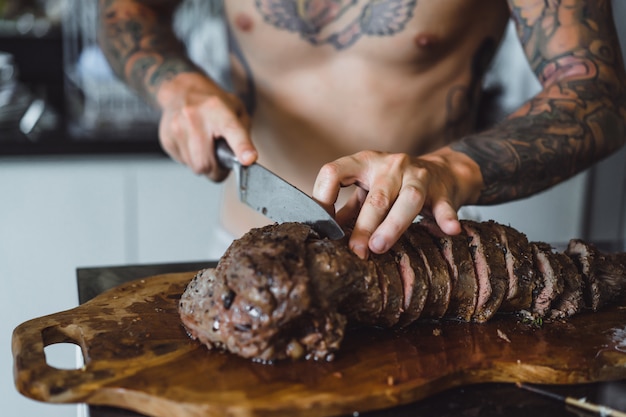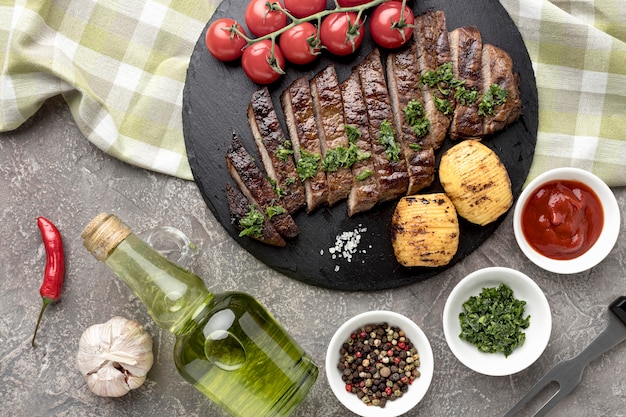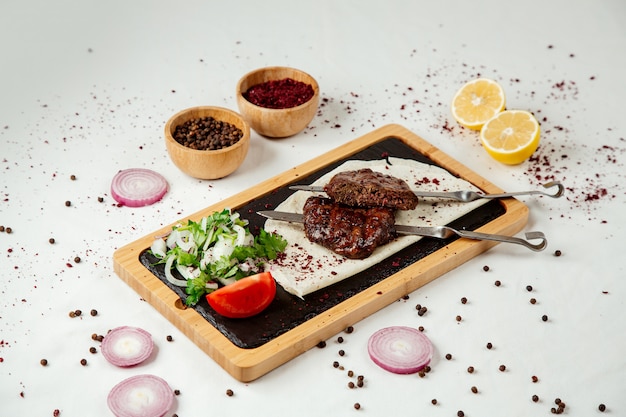There's something about a perfectly cooked tenderloin steak that just makes you feel like royalty. It's a dish that deserves a special occasion, a fancy bottle of wine, and the company of good friends. As a seasoned cook, I've learned that a tenderloin steak is all about meticulous preparation and understanding the nuances of this delicate cut of meat. So, let's dive in and uncover the secrets to achieving the ultimate juicy, perfectly cooked tenderloin steak.
(Part 1) Choosing the perfect tenderloin

The Anatomy of a Tenderloin: A Cut Above the Rest
Before we get into the nitty-gritty of cooking, let's talk about the star of the show: the tenderloin. This cut, also known as the psoas major muscle, is a long, narrow strip found along the backbone. It's the muscle that doesn't get much use, which explains its legendary tenderness. Think of it as the "filet mignon" of the beef world, the crème de la crème of steak cuts.
What Makes a Tenderloin a Winner
Choosing the perfect tenderloin is like picking the right diamond for your engagement ring – you want it to be beautiful, flawless, and worth the splurge. Here's what you should look for:
- Marbling: The Magic of Fat: Marbling refers to the fat streaks running throughout the meat. It's the key to juicy, flavourful steaks. You want to choose a tenderloin with a good amount of marbling, like a nice, even sprinkling of pepper flakes. Don't be afraid to pay a bit extra for a well-marbled cut; it's worth it!
- Colour: Deep Red is Best: A vibrant, deep red colour indicates a fresh, healthy piece of meat. Avoid tenderloins that look pale, grey, or have a dull surface. These are signs that the meat might be older or not stored properly.
- Texture: Springy and Firm: When you gently press your finger on the tenderloin, it should spring back quickly. A firm texture means the meat is fresh and well-handled. If it feels mushy or soft, give it a miss.
- Thickness: Finding the Right Fit: Tenderloins come in various thicknesses, and the thickness you choose depends on your cooking method. For grilling or pan-searing, a thicker cut will hold up better, ensuring a nice, even cook. A thinner cut is ideal for slow roasting, where the meat has more time to tenderize.
Where to Find the Perfect Tenderloin
A good quality butcher is your best friend when it comes to finding a perfect tenderloin. They'll know their cuts, their suppliers, and can even advise on the best way to cook your chosen steak. But if you don't have a local butcher, look for a reputable supermarket with a good meat counter. Ask the staff for their recommendations and don't be afraid to ask questions – it's better to be safe than sorry!
(Part 2) Prepping the Tenderloin: Setting the Stage for Success

Let It Rest: A Crucial First Step
You wouldn't jump into a freezing cold swimming pool, would you? Well, the same goes for your tenderloin. It needs a chance to come up to room temperature before hitting the heat. Bringing it to room temperature ensures even cooking, prevents cold spots, and helps the steak cook more evenly. Let it rest for at least 30 minutes before cooking – this is a crucial step that many people overlook.
Seasoning: Enhancing the Natural Flavours
Salt and pepper are your best friends when it comes to seasoning tenderloin. They bring out the natural flavour of the meat, and a little goes a long way. Season generously, but don't overdo it. The seasoning should enhance the natural beef flavour, not mask it.
Thinking Outside the Salt and Pepper Box
While salt and pepper are classics for a reason, don't be afraid to get creative. A sprinkle of garlic powder, onion powder, or even a pinch of cayenne pepper can add a wonderful dimension to your tenderloin. A little bit of fresh rosemary or thyme can also add a lovely, aromatic touch.
(Part 3) Cooking Methods: Four Ways to Tenderloin Perfection

1. Grilling: Bringing Out the Char
Grilling is a fantastic way to cook tenderloin, especially in the summer. It gives the steak a beautiful char, smoky flavour, and adds a touch of rustic charm. But remember: preheat your grill to medium-high heat and oil the grates to prevent sticking. This will ensure your tenderloin gets those gorgeous grill marks and doesn’t stick to the grates.
2. Pan-Searing: Quick and Easy
For a quick and easy meal, pan-searing is your go-to. It's a simple, yet elegant way to cook a tenderloin. Use a heavy-bottomed pan, heat it over medium-high heat, and add a drizzle of olive oil or your favourite cooking fat. Then, sear the tenderloin for a few minutes per side, creating a beautiful, crispy crust.
3. Slow Roasting: Tenderness Beyond Compare
For a tenderloin that's melt-in-your-mouth tender, slow roasting is the way to go. Preheat your oven to 325°F (160°C) and roast the tenderloin for 15-20 minutes per pound. This slow cooking method allows the fat to render and the meat to become incredibly juicy.
4. reverse searing: The Ultimate Tenderloin Hack
Reverse searing is like the secret handshake of the steak world. It combines the best of both worlds – low and slow cooking for maximum tenderness, followed by a final sear for a crispy crust. Start by cooking the steak low and slow in the oven until it reaches an internal temperature of 125°F (52°C) for medium-rare. Then, finish it off on the grill or in a pan over high heat, searing it for a few minutes per side. This method results in a tender, juicy steak with a perfect crust.
(Part 4) cooking times and Temperatures: Mastering the Heat
Rare, Medium-Rare, Medium, Medium-Well, or Well Done?
Here's where we get into the heart of the matter. Every steak lover has a preference, and the way you cook your tenderloin depends on how you like it. Here's a quick guide to internal temperatures for different levels of doneness:
| Doneness | Internal Temperature (°F) | Internal Temperature (°C) |
|---|---|---|
| Rare | 125-130 | 52-54 |
| Medium-Rare | 130-135 | 54-57 |
| Medium | 140-145 | 60-63 |
| Medium-Well | 150-155 | 65-68 |
| Well Done | 160 | 71 |
The meat thermometer: Your Essential Tool
A meat thermometer is your best friend when it comes to cooking tenderloin. It eliminates the guesswork and ensures your steak is cooked to your desired level of doneness. No more slicing into the steak with anxiety, hoping for the best! Simply insert the thermometer into the thickest part of the steak, making sure it doesn't touch any bone.
(Part 5) Resting and Slicing: The Finishing Touches
Resting: The Key to Juicy Deliciousness
Just like a marathon runner needs a breather, your tenderloin needs a moment to recover after its heat ordeal. Resting allows the juices to redistribute throughout the meat, resulting in a more tender and flavorful steak. Let the tenderloin rest for at least 10 minutes before slicing – it's the secret to juicy, perfectly cooked perfection.
Slicing: Against the Grain for Tender Bites
Now, the moment of truth – slicing your tenderloin. For the best presentation and texture, slice it against the grain. This means slicing across the muscle fibers, creating tender, juicy bites that melt in your mouth.
(Part 6) Serving Your Tenderloin: The Final Flourish
Sauces and Sides: Elevating the Experience
Tenderloin is delicious on its own, but it's even better with the right accompaniments. A classic Béarnaise sauce is always a winner, but you can also experiment with other sauces like chimichurri, peppercorn sauce, or even a simple pan sauce made with the cooking juices.
side dish Suggestions: The Perfect Compliments
To complement your tenderloin, choose side dishes that enhance the flavours and textures of the steak. Some of my favourites include:
- Roasted Vegetables: A medley of roasted vegetables, like asparagus, Brussels sprouts, or carrots, adds a burst of flavour and colour to your plate.
- Creamy mashed potatoes: A comforting and creamy side that perfectly balances the richness of the steak.
- Asparagus: fresh asparagus, grilled or roasted, adds a delicate, earthy flavour that complements the tenderloin beautifully.
- green beans: A classic side that's easy to prepare and provides a refreshing contrast to the richness of the steak.
- A Simple Salad: A light and refreshing salad with a vinaigrette dressing adds a touch of acidity and balances the richness of the tenderloin.
(Part 7) Tenderloin Hacks: Insider Tips and Tricks
1. The Reverse Sear Method: A Game-Changer
Remember, we talked about this earlier, but it deserves another mention. Reverse searing is the ultimate tenderloin hack. It ensures a tender, juicy steak with a beautiful crust. Cook the steak low and slow in the oven until it reaches an internal temperature of 125°F (52°C) for medium-rare. Then, finish it off on the grill or in a pan over high heat, searing it for a few minutes per side. The results are truly remarkable.
2. Brining Your Tenderloin: Boosting Moisture and Flavor
Brining involves soaking the meat in a saltwater solution, which helps to retain moisture and enhance the flavour. This is especially useful for leaner cuts of tenderloin. To brine your tenderloin, dissolve salt and sugar in water, add aromatics like garlic and herbs, and submerge the tenderloin in the solution for 2-4 hours.
3. Using a Meat Thermometer: Eliminate the Guesswork
We've mentioned it before, but it's worth repeating – a meat thermometer is your best friend when it comes to cooking tenderloin. It eliminates the guesswork and ensures your steak is cooked to your desired level of doneness.
(Part 8) FAQs: Your Tenderloin Questions Answered
Q1: Can I freeze tenderloin?
Yes, you can freeze tenderloin, but it's best to freeze it whole or in thick slices. Wrap it tightly in plastic wrap or freezer paper to prevent freezer burn. It can be kept frozen for up to 3 months. But remember, the texture might change a bit after freezing, so it's best to thaw it in the refrigerator overnight before cooking.
Q2: How long does it take to cook a tenderloin?
The cooking time for a tenderloin depends on its size and the cooking method used. A general rule of thumb is to cook a 1-inch thick tenderloin for 4-5 minutes per side. For thicker cuts or slow roasting, you'll need to adjust the cooking time accordingly.
Q3: What is the best way to cook a tenderloin?
There is no one "best" way to cook tenderloin. It all comes down to personal preference. Some people prefer grilling, while others enjoy pan-searing or slow roasting. Experiment and find what works best for you. Remember, the key is to cook it to your desired level of doneness and allow it to rest before slicing.
Q4: Can I cook tenderloin in a crock pot?
While you can cook tenderloin in a crock pot, it's not the ideal method. Tenderloin is best cooked using methods that involve high heat, such as grilling, pan-searing, or reverse searing. Cooking it in a crock pot can result in a mushy texture, and it won't give you the beautiful sear.
Q5: What are some tips for getting a crispy crust on tenderloin?
To get a crispy crust on your tenderloin, make sure to preheat your grill or pan to high heat and sear the steak for a few minutes per side. You can also use a cast iron skillet for a beautiful sear. Before searing, pat the steak dry with paper towels to remove any excess moisture. This will help create a crisp crust.
So, there you have it – a comprehensive guide to cooking the ultimate tenderloin steak. Now, grab your favourite recipe, gather your loved ones, and enjoy this culinary masterpiece!
Everyone is watching

How to Cook Frozen Lobster Tails Perfectly: A Step-by-Step Guide
RecipesLobster. Just the word conjures up images of lavish meals, special occasions, and a taste of luxury. But let's...

Pigs in a Blanket Cooking Time: How Long to Bake for Perfect Results
RecipesAh, pigs in a blanket. Just the name conjures up images of those delightful little parcels of crispy pastry en...

Pork Fillet Cooking Time: How Long to Cook It Perfectly
RecipesPork fillet, or tenderloin as it's sometimes called, is a real favourite in our house. It's so versatile, and...

The Ultimate Guide to Cooking Delicious Frankfurters
RecipesLet's face it, we all love a good frankfurter. It's a classic, simple, and always satisfying. But let's be rea...

Wolf Meat Recipes: A Guide to Cooking Wild Game
RecipesLet's be honest, you don't see wolf meat at your local butcher shop every day. It's a bit of a wild card, but ...
